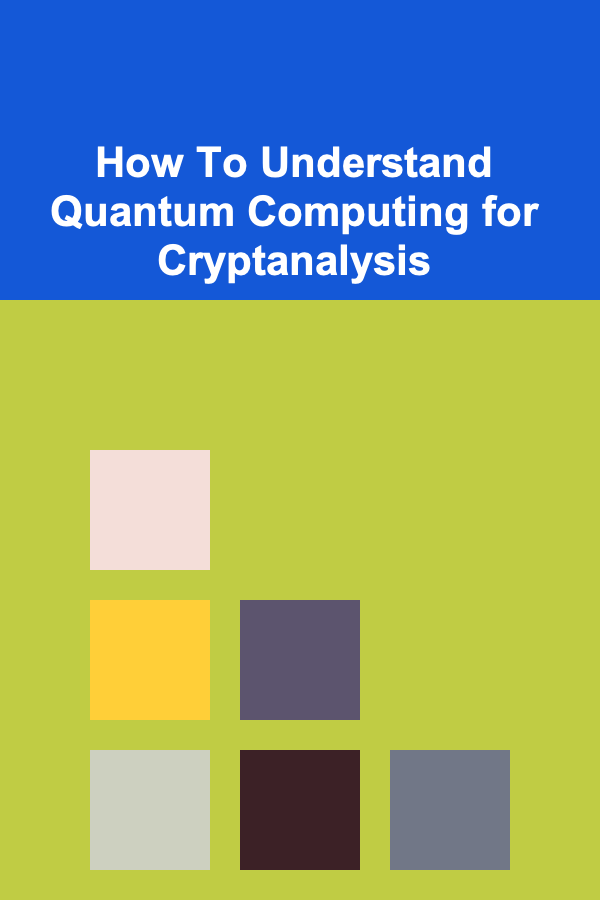
How To Understand Quantum Computing for Cryptanalysis
ebook include PDF & Audio bundle (Micro Guide)
$12.99$8.99
Limited Time Offer! Order within the next:

Quantum computing is rapidly becoming one of the most important fields in computing, with the potential to revolutionize industries ranging from cryptography to artificial intelligence. In the context of cryptanalysis--- the process of breaking or cracking encryption algorithms--- quantum computing is particularly significant. It has the potential to undermine many of the traditional cryptographic systems that are widely used today. In this article, we will explore the basics of quantum computing, its implications for cryptanalysis, and how it might shape the future of cybersecurity.
The Basics of Quantum Computing
Quantum computing is based on the principles of quantum mechanics, the branch of physics that deals with the behavior of particles on a very small scale--- such as atoms and photons. Unlike classical computers, which use bits as the basic unit of information, quantum computers use quantum bits , or qubits.
Classical vs. Quantum Bits
In classical computing, a bit can be either a 0 or a 1, which corresponds to the binary nature of traditional computer systems. A bit is a discrete entity that can be in one of two states at any given time.
On the other hand, a qubit can exist in a state of 0, 1, or a superposition of both 0 and 1 simultaneously. This ability to be in multiple states at once gives quantum computers the potential to perform many calculations simultaneously, providing an exponential speed-up for certain types of problems.
Furthermore, qubits are subject to entanglement, a phenomenon in which the state of one qubit is directly related to the state of another, even if they are separated by large distances. This entanglement allows quantum computers to process information in ways that are impossible for classical computers.
Quantum Gates and Algorithms
Quantum computing leverages quantum gates to manipulate qubits. These gates perform operations on qubits, similar to how classical logic gates operate on bits. However, due to quantum phenomena like superposition and entanglement, quantum gates can achieve far more complex operations than classical gates.
Several quantum algorithms have been proposed, but one of the most significant in the context of cryptanalysis is Shor's algorithm.
Quantum Computing and Cryptography
Cryptography relies on the fact that certain mathematical problems are computationally difficult to solve. Classical cryptographic systems, like RSA , Elliptic Curve Cryptography (ECC) , and Diffie-Hellman key exchange, depend on the difficulty of factoring large numbers or solving discrete logarithms. These problems are thought to be "hard" for classical computers, meaning they would take an infeasible amount of time to solve using current computational methods.
RSA and ECC Encryption
RSA encryption, for instance, is based on the fact that factoring large composite numbers is a problem that is extremely difficult for classical computers to solve. The security of RSA depends on the inability of classical computers to factor large numbers in a reasonable amount of time. Similarly, ECC relies on the difficulty of the Elliptic Curve Discrete Logarithm Problem (ECDLP), which involves finding a specific point on an elliptic curve given two points. Both of these cryptosystems are widely used to secure communications on the internet.
How Quantum Computing Threatens Traditional Cryptography
Quantum computers can potentially break these classical cryptographic algorithms by solving the hard mathematical problems they are based on in polynomial time. In particular, Shor's algorithm, which was proposed by mathematician Peter Shor in 1994, has the potential to factor large numbers and solve discrete logarithm problems efficiently. This algorithm is significant because it can factor large numbers exponentially faster than the best-known classical algorithms.
If a sufficiently powerful quantum computer were to be developed, it could use Shor's algorithm to efficiently break RSA and ECC encryption, rendering current security systems obsolete. The impact on cryptography would be profound, as millions of devices rely on these encryption schemes to secure data.
Shor's Algorithm and Its Implications for Cryptanalysis
Shor's algorithm is based on quantum Fourier transform, which allows quantum computers to find the period of a periodic function exponentially faster than classical computers. For example, the RSA encryption scheme relies on the difficulty of factoring large prime numbers. Shor's algorithm can factor large numbers in O((log N)³) time, where N is the number to be factored. For comparison, the best-known classical algorithm for factoring numbers is the general number field sieve (GNFS) , which runs in O(exp((64/9)^(1/3) * (log N)^(1/3))) time. This is much slower than Shor's algorithm, meaning quantum computers would be vastly superior at breaking RSA encryption.
The implications of Shor's algorithm are especially worrying for public-key cryptography, which relies on the fact that certain problems are difficult to solve. With quantum computers, this paradigm could be shattered.
Grover's Algorithm and Symmetric-Key Cryptography
While Shor's algorithm poses a direct threat to public-key cryptography, Grover's algorithm has implications for symmetric-key cryptography. Grover's algorithm is a quantum search algorithm that provides a quadratic speedup for brute-force search problems. In classical symmetric-key cryptography, the security of the system depends on the length of the key. For example, AES-256 encryption uses a 256-bit key, making it computationally infeasible for classical computers to crack by brute force.
Grover's algorithm can reduce the time complexity for finding the correct key from O(2^n) (where n is the key length) to O(2^(n/2)). This means that a quantum computer could theoretically break AES-256 encryption in about the same time it would take a classical computer to break AES-128 encryption. While AES-128 would still be vulnerable to quantum attacks, AES-256 would offer a higher level of security, though not as much as it does against classical attacks.
Hybrid Cryptographic Systems
In light of quantum threats, the cryptographic community is already considering quantum-resistant cryptography or post-quantum cryptography (PQC). These are cryptographic systems designed to be secure against both classical and quantum attacks. Some promising candidates for post-quantum cryptography include:
- Lattice-based cryptography: These cryptosystems rely on the hardness of problems in lattice theory, which are believed to be resistant to quantum attacks.
- Code-based cryptography: These cryptosystems rely on the hardness of decoding random linear codes, which also appear to be quantum-resistant.
- Multivariate quadratic equations: These cryptosystems rely on the difficulty of solving multivariate quadratic equations over finite fields.
Cryptanalysis in the quantum age will require adapting current cryptographic systems or transitioning to new ones. As quantum computers continue to develop, it will be crucial to implement new cryptographic standards that are resistant to quantum attacks while ensuring that they remain efficient and secure.
The Future of Cryptanalysis and Quantum Computing
Although we are not yet at a point where large-scale, fault-tolerant quantum computers are a reality, progress in the field is accelerating. Quantum computers that are capable of breaking RSA and ECC encryption may still be years or even decades away, but researchers and cryptographers are already preparing for this eventuality.
Quantum-Resistant Algorithms
One of the most critical areas of focus in the field of cryptanalysis is the development of quantum-resistant algorithms. The National Institute of Standards and Technology (NIST) has been running a process to standardize post-quantum cryptographic algorithms, and several algorithms are already being considered for deployment in the future. This research is vital to ensure that we have a secure cryptographic infrastructure in place before quantum computers become a reality.
Quantum Key Distribution (QKD)
In addition to developing new cryptographic algorithms, quantum computing also enables new methods of securing communication. Quantum Key Distribution (QKD) is one such method that leverages the principles of quantum mechanics to establish secure communication channels. In QKD, the key exchange is based on the quantum properties of photons, making it nearly impossible for eavesdroppers to intercept the key without being detected.
Cryptanalysis in the Quantum Era
Once quantum computers become widely available, cryptanalysis will undergo a profound transformation. Traditional methods of breaking encryption based on brute-force attacks or mathematical insights will be overshadowed by the power of quantum algorithms. For example, attacks on RSA, ECC, and other public-key systems will likely shift from being computationally infeasible to being executed in polynomial time. As a result, cryptanalysts will need to adapt and develop new strategies for analyzing quantum-resistant encryption.
Conclusion
Quantum computing represents both a profound opportunity and a significant challenge for cryptanalysis and cybersecurity. While the development of quantum computers will likely lead to the demise of many classical cryptographic systems, it also opens the door to new forms of secure communication and encryption. The cryptographic community is already taking steps to prepare for this quantum future, with the development of quantum-resistant algorithms and other innovative technologies.
As quantum computing continues to evolve, cryptanalysis will need to evolve as well. The challenge will be to find ways to protect sensitive data in a world where the power of quantum computers can potentially break the very systems that we rely on for security. The future of cryptography will depend on our ability to adapt to the quantum age and ensure that our systems are secure against both classical and quantum attacks.
Reading More From Our Other Websites
- [Home Cleaning 101] How to Clean a Home After a Party: Quick and Effective Tips
- [Home Cleaning 101] How to Clean an Oven: Step-by-Step Guide for a Spotless Appliance
- [Personal Investment 101] How to Understand and Successfully Buy Government Bonds for Portfolio Stability
- [Home Pet Care 101] How to Keep Your Pet Calm During Home Renovations or Changes
- [Home Family Activity 101] How to Make Homemade Friendship Bracelets
- [Horseback Riding Tip 101] Best Trail Riding Routes for Advanced‑Intermediate Riders in the Rocky Mountain Region
- [Home Budget Decorating 101] How to Add Style to Your Home with Thrift Store Finds
- [Home Holiday Decoration 101] How to Choose the Perfect Christmas Tree Topper for Your Home Decor Style
- [Scrapbooking Tip 101] Creative Themes to Transform Your Scrapbook Album
- [Personal Care Tips 101] How to Reduce Puffiness with Eye Cream

How to Create a Dream Closet on a Budget
Read More
How to Select and Style Vases and Bowls: A Comprehensive Guide
Read More
How to Use Baskets and Bins to Keep Your Home Tidy and Neat
Read More
How to Use Under-Bed Storage for Seasonal Items
Read More
How to Use Renewable Energy for Industrial Processes
Read More
10 Tips for Staying Up-to-Date with Email Marketing Trends
Read MoreOther Products

How to Create a Dream Closet on a Budget
Read More
How to Select and Style Vases and Bowls: A Comprehensive Guide
Read More
How to Use Baskets and Bins to Keep Your Home Tidy and Neat
Read More
How to Use Under-Bed Storage for Seasonal Items
Read More
How to Use Renewable Energy for Industrial Processes
Read More